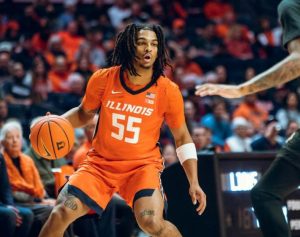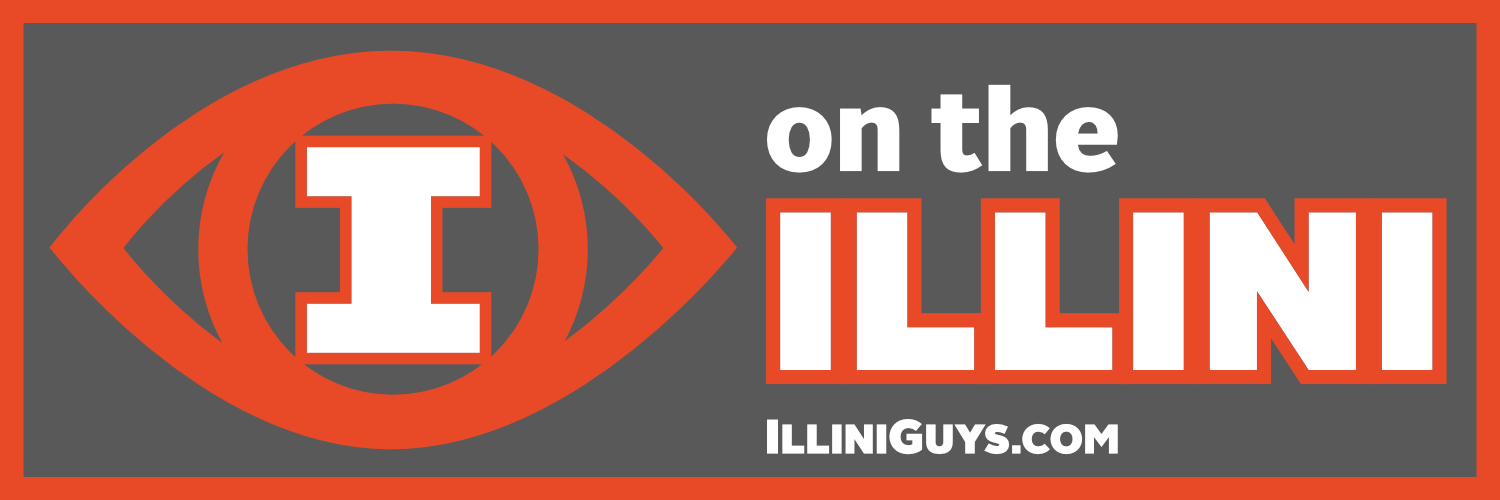Mike Cagley, Co-Host IlliniGuys Sports Spectacular
March 29, 2023

Brad Sturdy, the man who coined the term LIPO (Let It Play Out). Courtesy Mark Jones Photography
Are we in a new era of NCAA Tournaments? An era where even #16 seeds can realistically be confident of pulling off upsets of formerly invulnerable #1 seeds? Was this parity-filled season and this iteration of March Madness the new norm, or just a fluky year?
As we say at IlliniGuys, LIPO. For those reading who aren't IlliniGuys subscribers, who regularly check for nuggets of recruiting information back on our message board pages, LIPO means Let It Play Out. Apparently, our Uber Illini Insider Brad Sturdy has a way with phrases. If you're hearing LIPO from one of your friends, it's probably because he or she is an IlliniGuys subscriber.
Despite Brad's success with LIPO, I'm not here to try and match that by sticking a flag in the ground and saying I was one of the first to predict the changing future of the NCAA Tournament or this year’s “new look” Final Four. We will see how this trend evolves (or doesn't) over the next few years. Instead, let’s talk about when I think will be necessary to be in a position to make a Final Four run.
Heat Check #1 – Know Thy Team
The first step of dealing with building a team roster is for the staff to have a plan as to what the team should look like, what defense(s) they’d like to run, offense(s) to run, and the pace at which they’d like to play. Some of this is dependent upon the players who will be suited up, so the chicken or the egg argument has a degree of validity. At the same time, the coaches know what they like to coach and what they want to achieve and how they want to achieve their goals. Team design is in first place when trying to decide which players to recruit.
Heat Check #2 – Develop Requirements for Each Position
Once the offense and defense are determined, the coaches need to understand what they are looking for when choosing a player for any position. The staff must know what is required by position: three-point accuracy, ability to drive the basketball, play help defense, etc. Based on what is required by position, players may be rejected because they don't have the required athleticism or the physical size necessary to be successful doing what the team expects them to do. Others will be a clear fit precisely because of the physical traits they bring to the team. The more required traits possessed by a player (either skill-based or physical gifts) and the better those traits are, the more likely that higher amounts of NIL funds will be required to secure the players services – whether a high school recruit or Transfer Portal players.
Understanding what is needed by position, coupled with discipline and strong evaluation skills, the staff can recruit a roster that fits together well - and like a completed puzzle, doesn’t have any missing pieces. Players will enjoy more success because they will usually be asked to perform tasks they are well qualified to perform. The more often players succeed on the court, the more victories will be earned.
Heat Check #3 – Does a Player Fit?
The hardest question to answer is will a prospective recruit fit the team’s makeup? This requires the staff to either get to know a high school player, know the Portal player from past recruiting experiences, or meet with the Portal player to go over carefully designed questions and activities to better understand the player’s personality and preferences. It is critical to see if the staff can land a player who fits with the team’s offensive and defensive philosophies.
Finding a good fit to intangibles is as important as the players skills and much harder to accomplish than figuring out if his style of play fits the team. The player must be a good fit for the rest of the players’ personalities and the overall team culture. The player needs to be receptive to the type of coaching the staff offers.
To play for Coach Underwood a player might need to have certain traits such as competitiveness, initiative, adaptability, strong work ethic, and ability to learn. The staff needs to decide what traits are necessary in the "ideal" player and then be able to use these traits in the selection of players who will be the best fit for their roster. Much of the time spent with recruits should be evaluating the behaviors and traits that the staff desires. These traits will help players achieve success when times get tough or will keep them working hard when no coaches are around. The best players improve in large part to their own self-led practice time.
Another obvious but easily passed over factor for fit is if the player likes the school, its location, and the education they’ll be receiving. There’s no need to have a player who hates cold weather coming to the upper Midwest in the winter. No student wanting a degree in basket weaving will enjoy sitting through engineering classes, either. Fit matters in so many ways.
Heat Check #4 – Roster Composition – Get the Right Mix

Skyy Clark courtesy of Illinois Athletics.
At this point, the mix of the players comes into play. Last year, the Illini learned a tough lesson, experienced guards provide a huge advantage in college basketball, especially in the NCAA tournament. Going with a talented but unproven point guard didn’t work out when Skyy Clark left the team 13 games into the season in December.
A team needs young talent. It needs leaders. It needs accomplished basketball players at multiple positions. A team wants to get old and stay old, but it isn’t optimal to have to “get old” each year by going into the Portal with the staff having their backs to the collective wall because of unplanned for turnover.
The staff is under pressure to select the correct players to balance the roster from a class standpoint and from a positional standpoint. The guard position typically requires an experienced hand when March rolls around. The staff is charged with making sure to keep the position experienced and talented by bringing in talent when needed.
Over the course of time, it would be nice to not have to bring in talent to keep the team old, but instead to have the team’s players maturing through their career to make the team old. With talented players NBA opportunities can cause this issue as well as transfers out. Clearly the more players going to the NBA, the easier it is to recruit talented players to replace those leaving for the professional ranks.
Additionally, balancing the team from a positional view is also desirable. Use the portal to grab a big when needed, a 3&D wing, or whatever is needed. When it’s all said and done, the Portal is a place to fill holes in a perfect world. If things don’t work out on a larger scale (transfers or players that just don’t pan out), the Portal provides a way to rebuild almost instantly. There are concerns that if this “total Portal makeover” is done too often, it might raise a red flag amongst collegiate players – but it’s really too soon to know if that is true or not.
The Portal offers opportunities for coaches to improve their team quickly, but it also allows players to surprise the staff by deciding to run for greener pastures as opposed to fighting through obstacles. The first transfer no longer requires sitting out a season. One could argue the Portal encourages some players to cut and run when things get uncomfortable for them.
Heat Check #5 – Finding Alphas in the Portal

Ayo Dosunmu
Most alpha players (think former Illini Ayo Dosunmu) aren’t going to jump into the Portal, but that doesn’t mean there aren’t alpha dogs out there.
Most in the Portal are coming from bad situations – injury, poor fit with team, being recruited over, issues with the coach, or just needing a change. There may not be any players that are considered alphas currently within the Portal. Upon analysis though, there may be players with the talent and personality to be an alpha if the right situation occurs.
If the player is healthy, a good fit with the team, has the coaching staff’s confidence, or in a new set of circumstances, a player might develop into an alpha. It might take a season to build that trait back up, but it is possible. It’s not likely in year one, unless there’s a rare set of events that happens. Coaches need to figure out which players have this potential if they want to build stronger teams.
It's not wise to pressure players coming from the Portal in their first season at their new school to become alpha dogs on their new team. Year two or three might be totally different, though.
Heat Check #6 – Economics Matter
Entering the Portal means the school must have solid NIL support. It doesn’t appear that the Portal is as “expensive” as recruiting a Top 25 player (in most cases), but if a team’s resources are limited, it is critical to have a priority list of what they want by position from the Portal in any recruiting class.
Additionally, high school recruiting remains an important part of team construction. If high school recruiting is done well, the needs in the Portal will be less pressing - meaning less in overall number of players needed and in the amount of NIL dollars needed.
To stretch resources further (because few schools are Kentucky with a nearly endless supply of cash), coaching staffs must be able to identify high school talent ranked from 50 to 150 that is underrated and effectively recruit those players early to secure excellent players at the lowest cost possible. Sounds like the business world, to me.
Recruiting top ranked players is also a key (as they can be expensive) and doing so respectfully is critical – even if they ultimately decide to commit to another team. Many of the highest ranked players will transfer for a variety of reasons. Having strong relationships with highly ranked players can earn a team the chance to recruit these players a second time.
When these opportunities to recruit a highly ranked player who’s frustrated at another school happen, it is a huge advantage to already be on great footing with the player because when the recruitment went in another direction, the staff handled it with class and in a professional manner.
In building a team, NIL funds are a means to an end. How much is spent and who it is spent on is immaterial. In the end the team – the players and coaching staff will be judged based upon their on-court results - not how much is spent. The more NIL money that is spent, the more fan expectations elevate. If a player receives high visibility NIL deals, he or she must be prepared to be judged harshly if the play on the court is perceived to be worth less than any reputed big dollar NIL deal.
It is also worth noting that each season players need to be re-recruited. This is another area where NIL support is key. For many coaches, the consistency needed to compete in the NCAA tournament comes hand-in-hand with having an experienced team. One way to accomplish that is to retain your talent and keep them “at home”.
Like a business, it’s cheaper to keep a homegrown player around than it is to find a new player and have them come to a new university. For a Transfer Portal player, the potential NIL deals must be worth the pain of relocating, such as getting used to a new staff and teammates, rebuilding a reputation at a new school and the general uprooting of a person’s life when physically moving to a new school at a new location.
Heat Check #7 – Promises Matter

Another type of "Transfer Portal" Courtesy Clubit TV
On top of everything else, the words of the coaching staff matter. If they cannot be trusted, high school recruiting, Transfer Portal recruiting, and the building of a roster becomes nearly impossible to execute.
The easiest way to build a team is to never promise starting positions, minutes played, or shots taken. The cold reality of the marketplace is if one coach will not do so, it only takes a single coach to agree to such deals for the “easiest way” to become the excuse many recruits use to not play at a school. If such agreements are made, they must be carefully entered, and promises must be kept.
It’s not hard to understand why a many legendary coaches decided this new era was a perfect time to walk away from the game. The gap between the Blueblood programs and “everyday” programs have been leveled a bit by NIL. The players have more leverage with the Transfer Portal and its immediate first transfer.
There’s a lot of moving parts to build a winner and in this potentially new era of parity, players may seem to be more replaceable than ever before. Will coaches use the Transfer Portal to build teams or will the traditional pathway of high school recruiting lead to success?
No matter how it gets accomplished, the fans want successful tournament runs in March and occasional championships. To get them, teams need to be in the NCAA tournament year-after-year for the chance to get hot and go on a run.
Talent needs to be accumulated. Teams must be able to have experience, particularly at the guard position. Whether they are home grown talent or transfer in talent doesn’t matter. Load the roster with talent, add experience, and get it done in March. Fans won’t care how the roster was constructed, just win games.
The recent retirees were correct, it’s a tough world out there.

540 The Illini Execute the Braggin' Rights Massacre
Listen
12.19.25 - Illini FB in Music City Bowl, BB December Miscues & CFP Predictions
Listen
539 Remembering Mike White with Chris White & David Williams
Listen
538 - Illini Upset 83-80 by Nebraska
Listen
12.12.25 - Illini BB Over Vols, FB Commit Michael Clayton, Jr & Michigan Fiasco
Listen
537 - Illini Defeat Ohio State 88-80 on the Road
Listen
536 - Illini Crush Tennessee 75-62 with Huge 2nd Half
Listen
12.5.25 - #21 Illini FB Recruiting Class & Illini Men's BB vs Tenn
Listen
535 Illini FB 2025 Signing Day Special - Insider View
Listen
534 Illini FB 2025 Signing Day Special - Scouting View
Listen
533 Illini FB 2025 Signing Day Special - Reporter View
Listen
532 - Illini Win 8th Game this Season over Northwestern
Listen
Illini Frustration in the Big Apple #531
Listen
Illini FB vs Northwestern for Season Finale, Illini BB vs UConn & Game Predictions - S5Ep16 - 11.28.25 - Seg 1
Listen
Illini Cruise to Victory Over UTRGV 87-73 #530
Listen